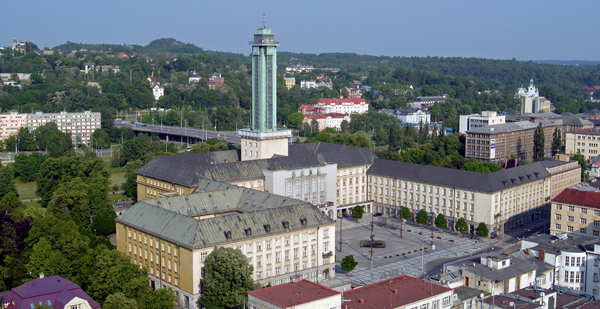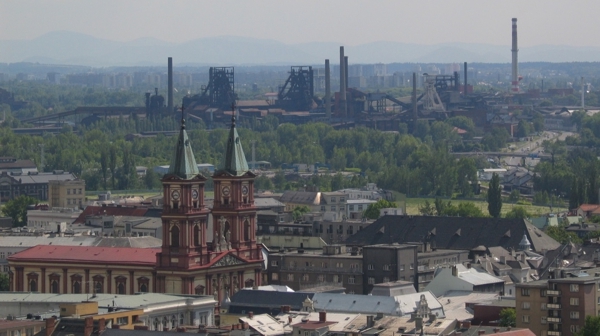Location
Ostrava is a city located in the northeast of the Czech Republic, in the Moravian-Silesian region at the confluence of the Odra and Ostravice rivers. As far as size and population are concerned, it is the third largest city in the Czech Republic. Ostrava is an industrial center of the black coal basin. Hence it is sometimes called "Black Ostrava". Black coal was mined here for centuries. The mining was terminated in the 1994. Since then, Ostrava has been trying to create a new modern look.
The relics of the long-standing black coal mining can be seen everywhere. There are empty shafts and also the remnants of drilling rigs. As a result of the long-standing coal mining and undermined ground, the sidewalks are in bad condition. Today, these artifacts of the past are greatly appreciated as not only the local people, but also tourists from all around the world, who visit and admire them. The Lower Vítkovice area, which includes the former Hlubina Coal Mine, blast furnaces and the Vítkovice coking plant, is a natural historic landmark registered in the European Cultural Heritage list. After it had been closed down, the Anselm coal mine located at the foot of the Landek Mountain, which is an oldest drift coal mine in the Ostrava region, was rebuilt into a unique mining museum. Moreover, there is also a museum in the former Michal Coal Mine in Michálkovice.

Millions of tons of dredging spoil from the Ostrava coal mines were placed on the Ema heap. The heap is still working and its surface is being heated by internal processes (the temperature inside the heap is 1500˚C). As a result, white clouds of gas (mainly of sulfur dioxide) are constantly rising from the heap. On the heap, there is a subtropical climate and the grass grows all year long. There is a tourist sign to the Ema heap.
Apart from coal mining, Ostrava is known for its ironworks and iron production, which continues until now. In the second half of the 20th century, the industrial development of the city led to it being called the "Steel Heart of the Republic". In some parts of the city, there still are funny carts on high wheels carrying steel ingots. Moreover, there is also the restored and interestingly lit Rothschild Villa, which contributed to the industrial development of the city.
Besides industry, Ostrava is also a center of shopping and entertainment. The local people shop mainly in shopping centers such as Avion Shopping Park, Futurum, Forum Nová Karolina, etc. Streets with small shops, typical for other cities, are no longer to be found in Ostrava. A unique phenomenon of Ostrava is the Stodolní Street with a number of bars, restaurants and clubs. A number of people (even from the outside of the city) spend their time there.
There are two public universities in Ostrava - the University of Ostrava and VŠB-Technical University of Ostrava.
Heavy industry influences the quality of environment in Ostrava and its surroundings. According to long-term measurement, air pollution in Ostrava and its surroundings is one of the highest in the entire Czech Republic. It affects the weather - inversion in the fall and winter. The sun is hidden behind the veil of clouds and fog for several weeks during that time. That is when the local people leave for the nearby mountains - the Beskydy Mountains (Lysá hora, Smrk, Radhošť) and Jeseníky Mountains, which - due to inversion - offer magnificent views of distant landscapes such as Tatra Mountains in Slovakia.

The industrial history of Ostrava is engraved in the hearts of the true people of Ostrava. They are used to hard and physically demanding work as well as harsh working and living conditions. This is reflected in their relationships - they tend to be reserved, detached and hopeless. Native people have a special bond with the city which prevents them - despite their life and other struggles - from leaving it. On the other hand, outsiders only rarely (and very slowly) become attached to the city. Generally, people tend to leave Ostrava, mainly due to harsh working and living conditions and exploitation to which Ostrava was subjected for centuries.
Ostrava is a city which attracts visitors because of the thousands of places that are often hidden from public view but that offer unforgettable experience once they are discovered. Some of them are beautiful and tender, full of hope and joy. Others, in other places and other time, are gloomy and dark, full of sadness and hopelessness. Like life itself, Ostrava is a symbol of life and living, but also a symbol of the fight for survival. Ostrava has a big (steel and rusty) heart, which is beating with life and which - for generations - has given the lives of the locals meaning and order.
Today, Ostrava needs help from all of us. Therefore, we hope that you will accept the invitation to this year’s ICTE conference, which is being held in the city center. We believe that the meeting will enrich every one of us and will contribute to the transformation of the "steel heart" of Ostrava. Not only Ostrava, but also we - the organizers - invite you to the conference.
© Ostravská univerzita v Ostravě 2008 - 2024
Ostravská univerzita v Ostravá, Dvořákova 7, 701 03 Ostrava
